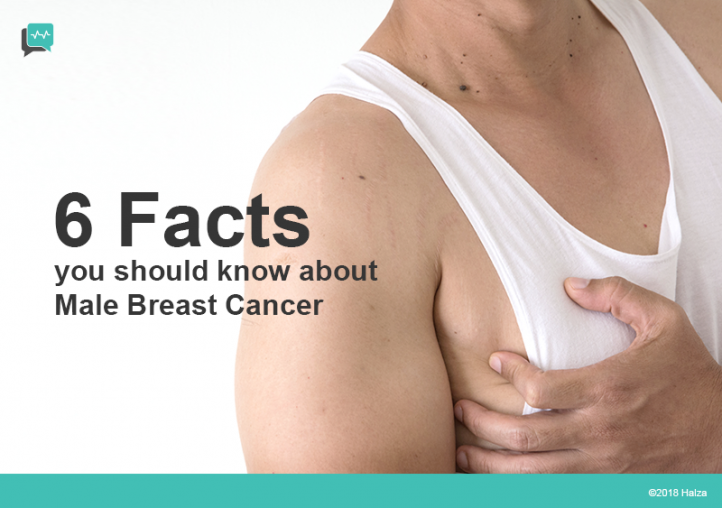6 Facts You Should Know About Male Breast Cancer

Breast cancer – along with skin cancer – is the most common type of cancer diagnosed in women. But here’s something that might surprise you: men can get it too. Although women are 100 times more likely to contract breast cancer than men, male breast cancer is just as deadly.
While men don’t have breasts per se, they do have breast tissue in their chests too. Breast cancer happens when breast cells mutate and form a malignant tumor, which can then spread to other parts of the body.
There’ve been many breast cancer prevention and awareness campaigns, but few are targeted towards men. Read on to find out more about male breast cancer.
1. There are a few types of male breast cancer
- Ductal Carcinoma in situ – where there is a tumour within the breast duct lining.
- Infiltrating ductal carcinoma – where cancerous cells have spread from the duct lining to surrounding tissue. This is the most common type of breast cancer diagnosed in men.
- Inflammatory breast cancer – where the breast is red and swollen, feels heavier and sometimes becomes larger than the other
- Paget disease of the nipple – where abnormal cells are found within the nipple, and on the surface of the nipple itself.
The latter two types of breast cancer are rare in men; most of the time, male breast cancer begins with a growth in the breast duct (ductal carcinoma).
2. Symptoms of male breast cancer are the same as that in females
Symptoms of breast cancer include the following:
- Lumps on the breast – this could even be painless
- Itching or flaking of the nipple
- Discharge or even bleeding from the nipple
- Dimpling of skin on the breast
- Sudden swelling or unevenness in breast size
- Inversion of nipple
- Thickening of skin and enlargement of pores on breast area
- Pain in the breast
Consult a doctor immediately if you have any of these symptoms.

3. Male breast cancer is often diagnosed in its later stages
Many men aren’t even aware that breast cancer doesn’t just affect women, so early symptoms such as painless lumps and flakiness often go ignored. By the time more severe symptoms such as bleeding of nipples are apparent and a visit to the doctor is finally made, the disease is already in its more serious stages – and the risk of mortality higher.
4. Genetics play a part in male breast cancer risk
If there is a history of breast cancer in your family, you’ll have an increased risk of getting the disease yourself. It doesn’t matter if your affected relatives are female or male – the genetic mutation that is passed down is the same.
While you may not have the disease at present, you could have inherited the mutated gene (BRCA1) from close relatives. Consider going for genetic testing and genetic counseling so you’ll be aware of your risk factor, and be able to keep a more watchful eye on your own health.
5. Obesity and exposure to radiation can increase one’s chances of getting male breast cancer
To prevent any sort of disease, it’s important to stay in shape, and it’s no different for breast cancer. Obese males have higher chances of getting breast cancer due to the larger amounts of estrogen in their bodies, and estrogen boosts the growth of breast cells, whether healthy or abnormal.
Other factors that contribute to higher estrogen levels:
- Ageing – as one grows older, testosterone drops and estrogen levels rise
- Hormones in food – some livestock have estrogen injected into them in order to make them grow faster
- Excessive drinking or liver problems – an unhealthy liver will not be able to properly regulate estrogen levels
Other than the above, having one’s chest exposed to radiation (for example, treatment for Lymphoma) can also add to the risk.

6. Men can and should get tested for male breast cancer too
Breast cancer screenings are mainly marketed towards women, but men can go for them too. As the occurrence of male breast cancer itself is already very minimal, there isn’t really a need to go for screenings as frequent as women. But it’ll do you good to perform a breast self-exam from time to time to check that there are no irregularities – especially if you’re at high risk.
If you find anything suspicious, visit your doctor immediately. You’ll be given a clinical breast exam, and in some cases, a mammogram to scan for any malignant tumours.
Breast cancer in males
It’s time we stop the stigma – breast cancer isn’t just a woman’s disease. And just like how we would naturally want to address warning symptoms of other diseases, so should men be attentive to possible signs and risks of breast cancer.
Awareness can help in early detection and higher chances of survival, so share this information with your loved ones to keep them in the know.




Download the full infographics here: Halza Male Breast Cancer Infographics
sources: Mayo Clinic – Breastcancer.org – CDC
Read more articles about Breast Cancer:


